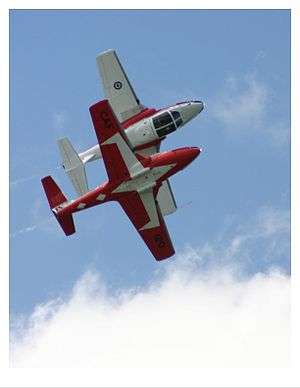Snowbirds
| 431 Air Demonstration Squadron Snowbirds | |
|---|---|
|
Snowbirds in a classic two-plane formation at the Winnipeg International Air Show 2004 | |
| Active |
25 June 1971 – present (as Snowbirds) 1 April 1978 – present (as 431 Air Demonstration Squadron) |
| Country |
|
| Branch |
|
| Role | Aerobatic flight demonstration team |
| Size |
80 Canadian Forces personnel full time 24 personnel in the show team |
| Part of | 15 Wing Moose Jaw |
| Garrison/HQ |
CFB Moose Jaw Moose Jaw, Saskatchewan, Canada |
| Nickname(s) | Snowbirds |
| Motto(s) | The Hatiten Ronteriios (Warriors of the air) |
| Colors | White and red |
| Website |
rcaf-arc |
| Commanders | |
| Commanding officer | LCol. Damon Brad (Squid) Wintrup[1] |
| Insignia | |
| Identification symbol |
 |
| Aircraft flown | |
| Trainer | 11 CT-114 Tutors |
Officially known as the Canadian Forces 431 Air Demonstration Squadron, the Snowbirds are Canada's military aerobatics or air show flight demonstration team whose purpose is to "demonstrate the skill, professionalism, and teamwork of Canadian Forces personnel".[2] The squadron is based at 15 Wing, near Moose Jaw, Saskatchewan. The Snowbirds are the first Canadian air demonstration team to be designated as a squadron.[3]
The show team flies 11 CT-114 Tutors—nine for aerobatic performances, including two solo aircraft, and two as spares, flown by the team coordinators. Approximately 80 Canadian Forces personnel work with the squadron full-time; 24 personnel are in the show team that travels during the show season. The Snowbirds are the only major military aerobatics team that operates without a support aircraft.[4]
The Snowbirds continue the flying demonstration tradition of previous Canadian air force aerobatic teams, which include the Siskins, the Blue Devils, the Golden Hawks, and the Golden Centennaires.
Squadron history
Second World War
Although 431 Air Demonstration Squadron was formed in 1978, its history truly begins during the Second World War when as part of the Commonwealth contribution to aircrew for the war in Europe 431 (Iroquois) Squadron Royal Canadian Air Force was created under the control of RAF Bomber Command.[5]
No. 431 Squadron formed on 11 November 1942, at RAF Burn (in North Yorkshire), flying Wellington B.X medium bombers with No. 4 Group RAF Bomber Command. The squadron moved to RAF Tholthorpe in mid-1943 as part of the move to bring all RCAF squadrons into one operational group – No. 6 Group RCAF – and converted to Halifax B.V four-engined heavy bombers. In December 1943 the squadron moved to RAF Croft where it was re-equipped with Halifax III's and later, Lancaster B.X aircraft. The squadron moved to RCAF Station Dartmouth, Nova Scotia after the war, disbanding there on 5 September 1945.
Battle honours
- English Channel and North Sea, 1943–1944
- Baltic, 1943–1944
- Fortress Europe, 1943–1944
- France and Germany, 1944–1945
- Biscay Ports, 1943–1944
- Ruhr, 1943–1945
- Berlin, 1943–1944
- German Ports, 1943–1945
- Normandy, 1944
- Rhine
- Biscay, 1943–1944
Postwar
Squadron re-formed
No. 431 (Fighter) Squadron re-formed at RCAF Station Bagotville on 18 January 1954, using the new Canadair F-86 Sabre. The squadron was formed on a temporary basis until there were enough new CF-100s available to fulfill RCAF squadron needs. No. 431's duties included aerial combat training and displaying the capabilities of jet operations to the public at air shows, the largest being Operation Prairie Pacific: a 50-minute exhibition that travelled to selected locations across western Canada. The team consisted of four Sabres and a solo aircraft. This was the first Sabre team to be authorized to perform formation aerobatics in Canada.[6] The unit was disbanded on 1 October 1954.
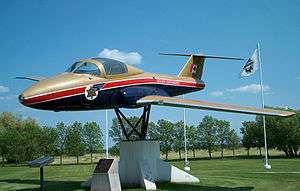

2 Canadian Forces Flying Training School Formation Team
In 1969, Colonel O.B. Philp, Base Commander of CFB Moose Jaw and former leader of the defunct Golden Centennaires aerobatic team, considered using several of the leftover Golden Centennaire CT-114 Tutor aircraft for another team. These Tutors were still fitted for aerobatic flying and because of some minor corrosion, had been painted with white anti-corrosive paint. Philp, at this point, did not receive approval to form the new team; however, approval had been given for single Tutors to provide simple flypasts at local pro football games. To further the cause of an aerobatic team, Philp began informal enhanced formation practice for the instructors at 2 Canadian Forces Flying Training School with the aim of providing multi-aircraft flypasts at special events. In 1970, four-aircraft formations began providing flypasts at fairs and festivals, as well as Armed Forces Day at CFB Moose Jaw. In July 1970, a white Tutor was introduced to the formation for flypasts. Four white Tutors were finally flown together at the Abbotsford Air Show, followed by a flypast in Winnipeg. Known as the 2 Canadian Forces Flying Training School Formation Team, or informally as the Tutor Whites, the team grew in size to seven aircraft in 1971 using eleven pilots, and gradually gained recognition. Formation flypasts were replaced with more complicated manoeuvres, and more aircraft were added as the team matured.
New name and squadron reactivation
A contest to give the air demonstration team a formal name was organized by Lt. Colonel Tom Reid and Senior Administrative Assistant Lois Boyle. The spirit building contest was held at the CFB Moose Jaw base elementary school (Bushell Park Elementary) and resulted in the name Snowbirds.[7] The name reflected the aircraft's distinctive mostly-white paint scheme used at the time, connoted grace and beauty and was clearly linked to its Canadian origins. Coincidentally, "Snowbird" was the name of an Anne Murray hit song that was popular at the time.[8] The name was formally adopted on 25 June 1971. The Snowbirds were officially authorized to be designated the Canadian Forces Air Demonstration Team on 15 January 1975. The team was formed into its own squadron by reactivating 431 Squadron (renamed 431 Air Demonstration Squadron) on 1 April 1978.
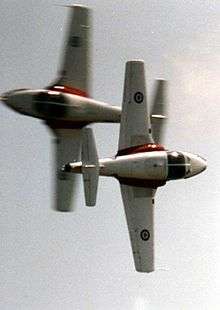
Show routine
Formations and manoeuvres are designed each season by the team, and must be approved by the Canadian Forces, Transport Canada and the United States Federal Aviation Administration (FAA) to ensure safety guidelines are complied with. FAA approval is necessary since the team performs in the United States.
Three shows are designed: an unrestricted high show, a modified high show where loops are not permitted because of cloud, and a low show where low cloud conditions do not permit higher manoeuvres. Some elements of the show are passed down from one season to the next. These include the Canada burst, heart, downward bomb burst, solo head on crosses, and their signature 9-abreast exit. Training occurs over several months. Once manoeuvres are mastered and the team is comfortable with the routine, the Snowbirds deploy to CFB Comox for specialized training. After approvals are obtained, an "acceptance show" is performed at Moose Jaw to allow representatives from the three approving agencies to see a live performance. The team will go on to perform shows throughout North America from May to October. The last show is performed at Moose Jaw.
The Snowbirds were the first aerobatic team in the world to use music in their show, and music is often used with live commentary from the performing pilots.[9]
The Snowbirds fly at speeds between 100 knots (190 km/h) and 320 knots (590 km/h), with a separation between aircraft of 1.8 metres (5.9 ft) in many of the formations. When two aircraft perform head-on passes, they aim to be about 10 metres (33 ft) apart.[10]
Awards, honours, and ambassadorships
In 1982, Canada Post released a 17¢ stamp of an inverted Snowbird No. 5 with the airframe number 114155.
On 8 June 1994, the Snowbirds were awarded the 1994 Belt of Orion Award for Excellence by Canada's Aviation Hall of Fame.
In September 1994, the Snowbirds were named the first ambassadors of the Canadian Injury Prevention Foundation (now renamed "Parachute"), which aims to educate Canadians about risk taking and injury prevention.
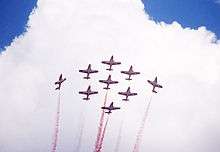
On 16 October 1999, the squadron was presented their squadron colour for 25 years of service. During the same ceremony the team was presented the 1999 Golden Hawks Award by the Air Force Association of Canada for outstanding performance in the field of Canadian military aviation.
In 2002, the Snowbirds were named ambassadors of the Ch.i.l.d. Foundation (Children with Intestinal and Liver Disorders Foundation).
On 28 June 2006, Canada Post released two domestic rate (51¢) stamps to commemorate the 35th anniversary of the team. The Royal Canadian Mint jointly released a $5 silver commemorative coin.
Notable performances
- The first performance of the team with the new name of "Snowbirds" was on 11 July 1971 at their home base of CFB Moose Jaw during the Homecoming '71 Air Show.
- The first performance of the Snowbirds in the United States occurred on 27 November 1971 at Williams Air Force Base near Phoenix, Arizona.[8]
- The first formal public performance that included opposing solos was flown at Yellowknife on 13 May 1972.[11]
- The air show at Inuvik, North West Territories, in 1974 was the first time that an aerobatic team had performed at midnight (daylight conditions north of the Arctic Circle).[12]
- The first official air show performed by the Snowbirds as 431 (Air Demonstration) Squadron was on 28 April 1978 at Royal Roads Military College, Victoria, British Columbia.[2]
- The opening ceremonies at the Calgary 1988 Winter Olympics was the first time the Snowbirds used coloured smoke. The colours represented the five colours of the Olympic rings.[13]
- In 1990 red smoke was incorporated into the Snowbirds' routine at major performances to commemorate the team's 20th anniversary and the silver anniversary of the Canadian flag.[14]
- The Snowbirds' 1000th official air show was performed on 20 May 1990 at CFB Edmonton (Namao).[2]
- The team performed for the first time outside of Canada and the United States in October 1993 at Zapopan Military Air Base near Guadalajara, Mexico.[15]
- The Snowbirds' 2000th official air show was performed on 17 September 2005 at Reno, Nevada.[16]
- The Snowbirds' 2500th official air show was performed on 29 August 2015 at Drummondville, Quebec.[17]
- The Snowbirds overfly the Canada Day celebrations at Parliament Hill, Ottawa on 1 July.
Notable staff
- Lois Boyle (b. Shellbrook, Sask., 8 June 1932 – d. Regina, Sask., 5 January 2012): in her role as a civilian senior administrative assistant to several base commanders of CFB Moose Jaw, Boyle was closely involved in the birth of the Snowbirds and also helping them mature into the 1980s. Boyle arrived at the base in late 1950s and became so valuable to its workings that she was one of only two civilians to receive a Centennial Medal. She was said to be invaluable as a base commander's aide. For her years of dedication and support to the team she earned the title 'Mother of the Snowbirds', and her funeral ceremony was marked with an honorary flyover by seven Snowbird jets.[18]
Accidents
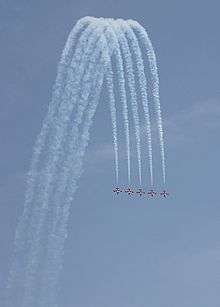
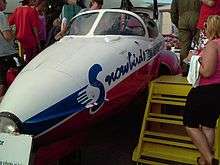
Snowbird aircraft have been involved in many accidents, including several mid-air collisions, resulting in the deaths of seven pilots and one passenger and the loss of several aircraft. The RCAF commented: "...there is risk associated with formation flying. Flying by its very nature has an inherent element of risk. Eight Snowbird pilots have lost their lives in the performance of their duty. We remember them." [19]
- 10 June 1972: Solo Captain Lloyd Waterer died after a wingtip collision with the other solo aircraft while performing an opposing solo manoeuvre at the Trenton Air Show at CFB Trenton, Ontario.[20]
- 14 July 1973: While performing a practice airshow at Moose Jaw, Captain Carl Stef ejected from his aircraft after a bird strike caused an engine compressor stall. Captain Stef suffered back injuries because of a hard parachute landing.[21]
- 16 July 1977: Two pilots ejected from their aircraft after colliding during a formation change while performing at Paine Field, Washington. The aircraft fell into Puget Sound and there were no serious injuries.[22][23]
- 3 May 1978: Captain Gordon de Jong died at an air show in Grande Prairie, Alberta. The horizontal stabilizer failed, rendering the aircraft uncontrollable. Although pilot ejection was initiated, it was not successful.[24]
- 17 June 1986: Snowbird 10, piloted by Captain Bob Curran, and Snowbird 5, piloted by Captain Gino Tessier, collided while the team was en route from Moose Jaw to Medicine Hat. The collision occurred near Carmichael, Saskatchewan. Captain Curran ejected from his aircraft and sustained minor injuries; the aircraft was destroyed. Captain Tessier was able to fly his aircraft to Medicine Hat and landed safely.[25]
- 3 September 1989: Captain Shane Antaya died after a midair collision during a demonstration at the Canadian International Air Show during the CNE in Toronto, Ontario when his Tutor crashed into Lake Ontario. During the same accident, team commander Major Dan Dempsey safely ejected from his aircraft.[26]
- 26 February 1991: A Snowbird jet crashed during a routine training flight near Moose Jaw, Saskatchewan. The two pilots were not seriously injured.[27]
- 14 August 1992: A crash near Moose Jaw was blamed on a failed engine bearing. There were no injuries.[27]
- 1992: Two Snowbird aircraft collided near Bagotville, Quebec. The pilots ejected safely.[27]
- 21 March 1994: Two pilots ejected from their aircraft near Moose Jaw, sustaining minor injuries.[27]
- 1995: While performing a loop at Point Mugu, California, the Snowbirds flew into a flock of birds. Snowbird 1 lost its right windshield, Snowbird 5 lost its windshield and right gull door, and Snowbird 7's left wing was damaged. All aircraft landed safely.[28]
- 1997: Two Snowbird aircraft touched wingtips in mid-air in Glens Falls, New York. There were no injuries.
- 10 December 1998: Captain Michael VandenBos died in a midair collision during training near Moose Jaw.[29]
- 27 February 1999: The nose landing gear of aircraft No. 6 collapsed during a rough landing at CFB Moose Jaw after a practice air show. There were no injuries.[30]
- 4 September 2000: Aircraft No. 4 and No. 1 touched causing minor damage to the wing of one and the tail of the other shortly after takeoff before a demonstration for the Canadian International Air Show in Toronto. Both planes landed safely with no injuries.[31]
- 10 April 2001: As it landed in Comox, British Columbia in a nine-plane diamond formation, the nose and right wing landing gear of aircraft No. 5 collapsed. No one was injured.[32]
- 21 June 2001: Major Robert Painchaud and his passenger ejected after a midair collision between aircraft No. 1 and No. 5 as they attempted to rejoin the "Concord" nine-jet formation for a media shoot over Lake Erie near London, Ontario. The passenger sustained serious injury, but Major Painchaud suffered only bruising and the other aircraft was safely flown back to base.[33]
- 10 December 2004: Captain Miles Selby died in a midair collision during training near Mossbank, Saskatchewan while practising the co-loop manoeuvre. The other pilot, Captain Chuck Mallett, was thrown from his destroyed aircraft while still strapped into his seat. While tumbling towards the ground, he was able to unstrap, deploy his parachute and land with only minor injuries.[34]
- 24 August 2005: Captain Andrew MacKay ejected from Snowbird 8 due to engine failure near Thunder Bay, Ontario, during the warm-up for the Thunder in the Air air show. MacKay sustained only minor injuries.[35][36]
- 18 May 2007: Snowbird 2, Captain Shawn McCaughey fatally crashed during practice at Malmstrom Air Force Base near Great Falls, Montana due to a restraining strap malfunction.[37]
- 9 October 2008: A Snowbird Tutor piloted by newly recruited team member Captain Bryan Mitchell with military photographer Sergeant Charles Senecal crashed, killing both, near the Snowbirds' home base of 15 Wing Moose Jaw while on a routine, non-exhibition flight.[38][39]
- 1 March 2011: A Snowbird Tutor landed with gear up at CFB Moose Jaw after a routine training flight. There were no injuries.[40]
Aircraft replacement
The Government of Canada plans to replace the Tutors with new aircraft between 2026 and 2035, with a preliminary estimated cost of $500 million to $1.5 billion. Official sources were quoted: "The chosen platform must be configurable to the 431 (AD) Squadron standard, including a smoke system, luggage capability and a unique paint scheme. The platform must also be interchangeable with the training fleet to ensure the hard demands of show performances can be distributed throughout the aircraft fleet." [41] The objective of the Snowbird Aircraft Replacement Project is "to satisfy the operational requirement to provide the mandated Government of Canada aerobatic air demonstration capability to Canadian and North American audiences."[41]
References
Notes
- ↑ "Wintrup assumes command of Snowbirds’ squadron." The Moose Jaw Times Herald, 9 July 2015.
- 1 2 3 Dempsey 2002, p. 567.
- ↑ Dempsey 2002, p. 718.
- ↑ Dempsey 2002, p. 659.
- ↑ "Air of Authority – A History of RAF Organisation." rafweb.org. Retrieved: 20 May 2011.
- ↑ Dempsey 2002, p. 95.
- ↑ "Snowbirds - Full History." RCAF. Retrieved: 15 March 2013.
- 1 2 Dempsey 2002, p. 538.
- ↑ Dempsey 2002, p. 643.
- ↑ "FAQ: Snowbirds." Government of Canada, Royal Canadian Air Force, 20 July 2015. Retrieved: 12 August 2015.
- ↑ Dempsey 2002, p. 545.
- ↑ Dempsey 2002, p. 552.
- ↑ Dempsey 2002, p. 597.
- ↑ Dempsey 2002, pp. 605, 606.
- ↑ Dempsey 2002, p. 615.
- ↑ Aviation.ca - "Snowbirds celebrate 35 years of hearts." Government of Canada. Retrieved: 13 April 2013.
- ↑ "The Canadian Forces Snowbirds." The Canadian Forces Snowbirds Official Facebook Page. Retrieved: 22 November 2015.
- ↑ Ewing-Weisz (2012).
- ↑ "Snowbirds - Tributes." Royal Canadian Air Force, Government of Canada, 9 February 2015. Retrieved: 12 August 2015.
- ↑ Dempsey 2002, p. 546.
- ↑ Dempsey 2002, p. 550.
- ↑ Dempsey 2002, p. 563.
- ↑ "Two pilots rescued after jets collide." Spokesman Review, Spokane, Washington, July 17, 1977. Retrieved: 23 April 2014
- ↑ Dempsey 2002, p. 569.
- ↑ "Snowbirds collide in mid-air; pilots escape serious injury." Ottawa Citizen, 18 June 1986. Retrieved: 22 November 2015.
- ↑ Dempsey 2002, p. 602.
- 1 2 3 4 "A History of Snowbird Crashes." Canwest News Service. Retrieved: 23 April 2014.
- ↑ Dempsey 2002, p. 622.
- ↑ "Snowbird crash, December 10, 1998 – investigation update." airforce.forces.gc.ca, 7 June 2010. Retrieved: 16 June 2010.
- ↑ "Canadian Forces Flight Safety Report:CT114019 Tutor." airforce.forces.gc.ca, 27 February 1999. Retrieved: 7 April 2010. Archived June 11, 2011, at the Wayback Machine.
- ↑ "Canadian Forces Flight Safety Report:CT114172 Tutor and CT114006 Tutor." airforce.forces.gc.ca, 24 September 2000. Retrieved: 17 March 2014
- ↑ "Canadian Forces Flight Safety Report:CT114142 Tutor." airforce.forces.gc.ca, 10 April 2001. Retrieved: 17 March 2014.
- ↑ "Canadian Forces Flight Safety Report:CT114006 and CT114081 Tutor." airforce.forces.gc.ca, 21 June 2001. Retrieved: 7 April 2010.
- ↑ "Canadian Forces Flight Safety Report: CT114173 / CT114064 Tutor." airforce.forces.gc.ca, 10 December 2004. Retrieved: 17 March 2014.
- ↑ "Canadian Forces Flight Safety Report: CT114120 Tutor." airforce.forces.gc.ca, 24 August 2005. Retrieved: 17 March 2014.
- ↑ Bridges, Holly. "Snowbird safely ejects, Flight Safety investigation continues, p. 12." Maple Leaf, Vol 8., No. 31. 8 September 2005 via airforce.forces.gc.ca. Retrieved: 16 June 2010.
- ↑ "Canadian Forces Flight Safety Report: CT114159 Tutor." airforce.forces.gc.ca, 18 May 2007. Retrieved: 17 March 2014.
- ↑ "CBC News Story." CBC, 10 October 2008. Retrieved: 13 October 2008.
- ↑ "Canadian Forces Flight Safety Report." airforce.forces.gc.ca. Retrieved: 17 March 2014.
- ↑ "Tutor damaged upon landing at 15 Wing.” Moose Jaw Times Herald, 2 March 2011. Retrieved: 9 September 2011.
- 1 2 "Snowbird Aircraft Replacement Project." Government of Canada, 12 August 2015. Retrieved: 12 March 2015.
Bibliography
- Dempsey, Daniel V. A Tradition of Excellence: Canada's Airshow Team Heritage. Victoria, British Columbia, Canada: High Flight Enterprises, 2002. ISBN 0-9687817-0-5.
- Ewing-Weisz, Chris. "Lois Boyle was the ‘Mother of the Snowbirds’." The Globe & Mail, 17 January 2012, p. S8. Published online: 16 January 2012. Retrieved: 23 January 2012.
- Fast, Beverley G. Snowbirds: Flying High, Canada's Snowbirds Celebrate 25 Years. Saskatoon, SK: Lapel Marketing & Associates Inc., 1995. ISBN 0969932707.
- Milberry, Larry. Canada's Air Force At War And Peace, Volume 3. Toronto, ON: CANAV Books, 2000. ISBN 0-921022-12-3.
- Mummery, Robert. Snowbirds: Canada's Ambassadors of the Sky. Edmonton, Alberta, Canada: Reidmore Books, 1984. ISBN 0-919091-37-7.
- Rycquart, Barbara. The Snowbirds Story. London, Ontario, Canada: Third Eye, 1987. ISBN 0-919581-41-2.
- Sroka, Mike. Snowbirds: Behind The Scenes With Canada's Air Demonstration Team. Toronto, Ontario, Canada: Fifth House Publishers, 2006. ISBN 1-894856-86-4.
External links
| Wikimedia Commons has media related to Snowbirds. |
- Canadian Forces Snowbirds (official site)
- 431 Squadron (Department of Defence – History and heritage)
- Squadron history at Canadian Wings
- Watch a 1980 NFB vignette on the Snowbirds
- Snowbirds description from Encyclopedia of Saskatchewan
